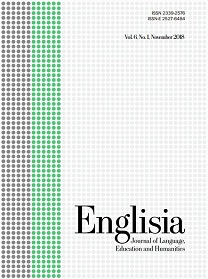The impact of bullying on EFL students’ academic achievement at state Islamic universities in Indonesia
DOI:
https://doi.org/10.22373/ej.v8i2.8996Keywords:
Bullying, Impacts of Bullying, Academic Achievement, Islamic UniversityAbstract
Issues and incidents of bullying may take place, regardless of time and place, notwithstanding at Islamic education institutions. This study is aimed at finding out types of bullying and their triggering factors taking place in the university classroom; examining steps taken by lecturers to anticipate and prevent classroom bullying; and analyzing the impact of bullying on EFL students’ academic achievement. This mixed-methods study involved 546 students and 30 lecturers of the English Language Education Department at three state Islamic universities in Indonesia; Universitas Islam Negeri Syarif Hidayatullah in Jakarta, Universitas Islam Negeri Sunan Kalijaga in Yogyakarta, and Universitas Islam Negeri Ar-Raniry in Banda Aceh. Both surveys and interviews were employed to collect the required data. The findings elucidate that physical, social, verbal, and racial are among the most common emergent bullying incidents the students experienced. Revealing the triggering factors of bullying, the data show that competition in academic and social life, differences in thoughts and appearances, lack of understanding of bullying meaning, and lack of regulation are pointed as the source of bullying. The findings also indicate that bullying influences students’ academic achievement; bullying incidents have driven their victims into four pathetic conditions: less confident, stressed, anxious, and passive. Some steps are applied by the lecturer to prevent and handle bullying; they are: providing classroom regulation, being a counselor for students, enforcing the regulation, and massive socialization.
Downloads
References
Al-Rahmi, W. M., Yahaya, N., Alamri, M. M., Aljarboa, N. A., Kamin, Y. B., & Moafa, F. A. (2018). A model of factors affecting cyber bullying behaviors among university students. IEEE Access, 7, 2978-2985.
Arıcak, O. T. (2009). Psychiatric symptomatology as a predictor of cyberbullying among university students. Eurasian Journal of Educational Research (EJER), (34).
Bowes, L., Maughan, B., Caspi, A., Moffitt, T. E., & Arseneault, L. (2010). Families promote emotional and behavioral resilience to bullying: evidence of an environmental effect. Journal of Child Psychology and Psychiatry, 51(7), 809-817.
Braithwaite, V., Ahmed, E., & Braithwaite, J. (2008). Workplace bullying and victimization: The influence of organizational context, shame and pride. International Journal of Organizational Behavior, 13(2), 71-94.
Branch, S., & Murray, J. (2015). Workplace bullying: Is lack of understanding the reason for inaction. Organizational Dynamics, 44(4), 287-295.
Byers, D. S. (2013). “Do they see nothing wrong with this?”: Bullying, bystander complicity, and the role of homophobic bias in the Tyler Clementi case. Families in Society, 94(4), 251-258.
Chernova, S. V. (2019). “Prank” as a speech genre of entertainment discourse in its culturological context. Philology at MGIMO, (8), 189-200.
Cismaru, M., & Cismaru, R. (2018). Protecting University Students from Bullying and Harassment: A Review of the Initiatives at Canadian Universities. Contemporary Issues in Education Research, 11(4), 145-152.
Coleyshaw, L. (2010). The power of paradigms: A discussion of the absence of bullying research in the context of the university student experience. Research in Post‐Compulsory Education, 15(4), 377-386.
Cowie, H., & Myers, C. A. (Eds.). (2015). Bullying among university students: Cross-national perspectives. Routledge.
de la Fuente, J., Zapata, L., Vera, M. M., González-Torres, M. C., & Artuch, R. (2014). Bullying, personal self-regulation, resilience, coping strategies and engagement-burnout: implications for an intervention with university students. Bullying, Prevalence, Psychological Impact, and Strategies Intervention, 91-107.
Eliot, M., Cornell, D., Gregory, A., & Fan, X. (2010). Supportive school climate and student willingness to seek help for bullying and threats of violence. Journal of School Psychology, 48(6), 533-553.
Espelage, D. L., Bosworth, K., & Simon, T. R. (2000). Examining the social context of bullying behaviors in early adolescence. Journal of Counseling & Development, 78(3), 326-333.
Goryl, O., Neilsen-Hewett, C., & Sweller, N. (2013). Teacher education, teaching experience and bullying policies: Links with early childhood teachers' perceptions and attitudes to bullying. Australasian Journal of Early Childhood, 38(2), 32-40.
Gruber¬, J. E., & Fineran, S. (2008). Comparing the impact of bullying and sexual harassment victimization on the mental and physical health of adolescents. Sex Roles, 59(1-2), 1.
Harrison, E. D., Fox, C. L., & Hulme, J. A. (2020). Student anti-bullying and harassment policies at UK universities. Journal of Higher Education Policy and Management, 1-16.
Harrison, E. D., Fox, C. L., & Hulme, J. A. (2020). Student anti-bullying and harassment policies at UK universities. Journal of Higher Education Policy and Management, 1-16.
Harthill, S. (2009). The need for a revitalized regulatory scheme to address workplace bullying in the United States: Harnessing the federal Occupational Safety and Health Act. U. Cin. L. Rev., 78, 1250.
Hollis, L. P. (2017). The need for anti-bullying policies on campus: An argument for improving gender and race relations in higher education. Journal of Black Sexuality and Relationships, 3(3), 29-46.
Hollis, L. P. (2017). The need for anti-bullying policies on campus: An argument for improving gender and race relations in higher education. Journal of Black Sexuality and Relationships, 3(3), 29-46.
Kern, T. (2010). The anti-bully campaign: Therapists share their tactics. Annals of the American Psychotherapy Association, 13(2), 30-32.
Kokkinos, C. M., Antoniadou, N., & Markos, A. (2014). Cyber-bullying: An investigation of the psychological profile of university student participants. Journal of Applied Developmental Psychology, 35(3), 204-214.
Laeheem, K. (2013). Guidelines for solving bullying behaviors among Islamic private school students in Songkhla province. Asian Social Science, 9(11), 83.
Lewis, D. (2004). Bullying at work: The impact of shame among university and college lecturers. British Journal of Guidance & Counselling, 32(3), 281-299.
Mahady Wilton, M. M., Craig, W. M., & Pepler, D. J. (2000). Emotional regulation and display in classroom victims of bullying: Characteristic expressions of affect, coping styles and relevant contextual factors. Social Development, 9(2), 226-245.
McCormick, M., & Krieger, M. (2020). Religion and bullying: Perspectives from sexual and gender minority youth (SGMY) in Michigan. Journal of Gay & Lesbian Social Services, 32(2), 191-208Cowie, H., & Myers, C. A. (2015). What we know about bullying and cyberbullying among university students. In Bullying among university students (pp. 3-14). Routledge.
Minton, S. J. (2014). Prejudice and effective anti-bullying intervention: Evidence from the bullying of “minorities”. Nordic Psychology, 66(2), 108-120.
Naylor, P., Cowie, H., Cossin, F., de Bettencourt, R., & Lemme, F. (2006). Teachers' and pupils' definitions of bullying. British Journal of Educational Psychology, 76(3), 553-576.
Ollis, D. (2013). 12 Planning and delivering interventions to promote gender and sexuality. Bullying: experiences and discourses of sexuality and gender, 145.
Otieno, O. I. (2018). Assessing the influence of prank shows on urban youth's Good Samaritanism (Doctoral dissertation, Daystar University).
Panúncio-Pinto, M. P., Alpes, M. F., & Colares, M. D. F. A. (2019). Interpersonal Violence/Bullying Situations at the University: Academic Daily Life Clippings among Students from Undergraduate Health Programs. Revista Brasileira de Educação Médica, 43(1), 537-546.
Parker, C. (2006). The “compliance” trap: The moral message in responsive regulatory enforcement. Law & Society Review, 40(3), 591-622.
Pörhölä, M., Cvancara, K., Kaal, E., Kunttu, K., Tampere, K., & Torres, M. B. (2020). Bullying in university between peers and by personnel: cultural variation in prevalence, forms, and gender differences in four countries. Social Psychology of Education, 23(1), 143-169.
Poteat, V. P., & DiGiovanni, C. D. (2010). When biased language use is associated with bullying and dominance behavior: The moderating effect of prejudice. Journal of Youth and Adolescence, 39(10), 1123-1133.
Roberto, A. J., Eden, J., Savage, M. W., Ramos-Salazar, L., & Deiss, D. M. (2014). Prevalence and predictors of cyberbullying perpetration by high school seniors. Communication Quarterly, 62(1), 97-114.
Sawyer, A. L., Bradshaw, C. P., & O'Brennan, L. M. (2008). Examining ethnic, gender, and developmental differences in the way children report being a victim of “bullying” on self-report measures. Journal of Adolescent Health, 43(2), 106-114.
Secundo, G., De Beer, C., Schutte, C. S., & Passiante, G. (2017). Mobilising intellectual capital to improve European universities’ competitiveness. Journal of Intellectual Capital.
Segrin, C., Nevarez, N., Arroyo, A., & Harwood, J. (2012). Family of origin environment and adolescent bullying predict young adult loneliness. The Journal of Psychology, 146(1-2), 119-134.
Shelley, W. W., Pickett, J. T., Mancini, C., McDougle, R. D., Rissler, G., & Cleary, H. (2017). Race, bullying, and public perceptions of school and university safety. Journal of Interpersonal Violence, 0886260517736272.
Singh, K. (2017). Measurement and Assessment of Bullying Behaviours in Departments and Affiliated Colleges of University of Delhi. PEOPLE: International Journal of Social Sciences, 3(2).
Skinner, T. C., Peetz, D., Strachan, G., Whitehouse, G., Bailey, J., & Broadbent, K. (2015). Self-reported harassment and bullying in Australian universities: explaining differences between regional, metropolitan and elite institutions. Journal of Higher Education Policy and Management, 37(5), 558-571.
Sullivan, K. (2010). The anti-bullying handbook. Sage.
Sutton, J., Smith, P. K., & Swettenham, J. (1999). Social cognition and bullying: Social inadequacy or skilled manipulation?. British Journal of Developmental Psychology, 17(3), 435-450.
Turan, N., Polat, O., Karapirli, M., Uysal, C., & Turan, S. G. (2011). The new violence type of the era: Cyber bullying among university students: Violence among university students. Neurology, psychiatry and brain research, 17(1), 21-26.
Walker, C. M., Sockman, B. R., & Koehn, S. (2011). An exploratory study of cyberbullying with undergraduate university students. TechTrends, 55(2), 31-38.
Wensley, K., & Campbell, M. (2012). Heterosexual and nonheterosexual young university students' involvement in traditional and cyber forms of bullying. Cyberpsychology, Behavior, and Social Networking, 15(12), 649-654.
Williams, K. D., Forgas, J. P., & Von Hippel, W. (Eds.). (2005). The social outcast: Ostracism, social exclusion, rejection, and bullying. Psychology Press.
Xiao, B. S., & Wong, Y. M. (2013). Cyber-bullying among university students: An empirical investigation from the social cognitive perspective. International Journal of Business and Information, 8(1).
Young-Jones, A., Fursa, S., Byrket, J. S., & Sly, J. S. (2015). Bullying affects more than feelings: The long-term implications of victimization on academic motivation in higher education. Social psychology of education, 18(1), 185-200.
Downloads
Published
Issue
Section
License
Proposed Policy for Journals That Offer Open Access
Authors who publish with Englisia journal agree to the following terms:
- Authors retain copyright and grant the journal right of first publication with the work simultaneously licensed under a Creative Commons Attribution License that allows others to share the work with an acknowledgement of the work's authorship and initial publication in this journal.
- Authors are able to enter into separate, additional contractual arrangements for the non-exclusive distribution of the journal's published version of the work (e.g., post it to an institutional repository or publish it in a book), with an acknowledgement of its initial publication in this journal.
- Authors are permitted and encouraged to post their work online (e.g., in institutional repositories or on their website) prior to and during the submission process, as it can lead to productive exchanges, as well as earlier and greater citation of published work (See The Effect of Open Access).









